Tue 14 Apr 2009
The Passover Diet Continues
Posted by Bria under Main Dishes
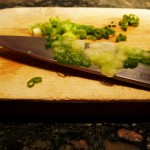
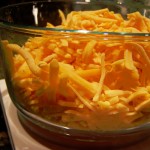
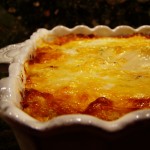
The Midwest is well-known for its casserole canon. You have your hot dish, your noodle ring – the sorts of oven-baked concoctions that appear in starring roles at stock the fridge showers for a second babies in Wisconsin (and seem to make their way into every kitschy portrayal of Midwesterners in film and on television). It’s a lesser-known fact that Utah also boasts a mean casserole repertoire. I know, you’re thinking that Utah is known for having lots of one thing…
…Jello. And you’d be right. I believe Utah consumes more Jello than the rest of the country put together. As much as I have tried to disavow it at varying points in my life, I can’t help it; I love me some rainbow Jello cake. I have made it once, and it was a colossal pain, but so worth it. The next time I have a free day and am on a sugar binge, I’ll whip one up and show you. It’s just…wow. Unlike anything you’ve ever seen.
But we’re here to talk casserole (to dish about casserole? Ouch). I’m pulled in a casserole way by more than nostalgia. They are an ideal endeavor for busy people; a little work up front and you can eat well for several servings (and if the thought of eating lasagna for four consecutive meals makes you ill, they often freeze well). In some circles, the act of creating one of these baked wonders is called “putting up” a casserole, which I cannot explain linguistically but love and use often. It’s one of those charming bits of vernacular that you want to snatch up and squeeze for yourself because it hits the ear just right. Or maybe I just like things that sound vaguely Southern.
Whatever, let’s put up a Passover casserole.
Farfel and Cheese
Serves 8-10
Adapted from Joan Nathan’s Jewish Holiday Kitchen Cookbook
This is absolutely delicious. It is very reminiscent of macaroni and cheese. I like it as-is; John prefers to add ketchup or tabasco. FYI - one large can of farfel is enough for 2 batches.
3 cups farfel
3 egg whites
2 eggs
1 scallon, diced
½ lb cheddar cheese, shredded
2 cups milk
1 ½ c nonfat (plain) yogurt
Salt and pepper
Butter
Preheat the oven to 350.
In a medium bowl, whisk one egg and the egg whites with a fork. Fold in the farfel, stirring well until the mixture is fully combined and there are no dry spots of farfel left. Stir in the scallion.
Use a bit of butter to grease an 8×8” casserole dish. Spread the farfel mixture into an even layer. Using the same bowl you used to mix the farfel, whisk together the milk, yogurt, remaining egg, and about a teaspoon of salt. Add a few turns of freshly ground pepper.
Cover the farfel mixture with the shredded cheddar cheese in one, even layer. I save time by buying giant bags of shredded cheese at Costco and freezing it into small ziplocks, but you can also often find shredded cheese on sale at the grocery store. It’s worth stocking up, it freezes very well.
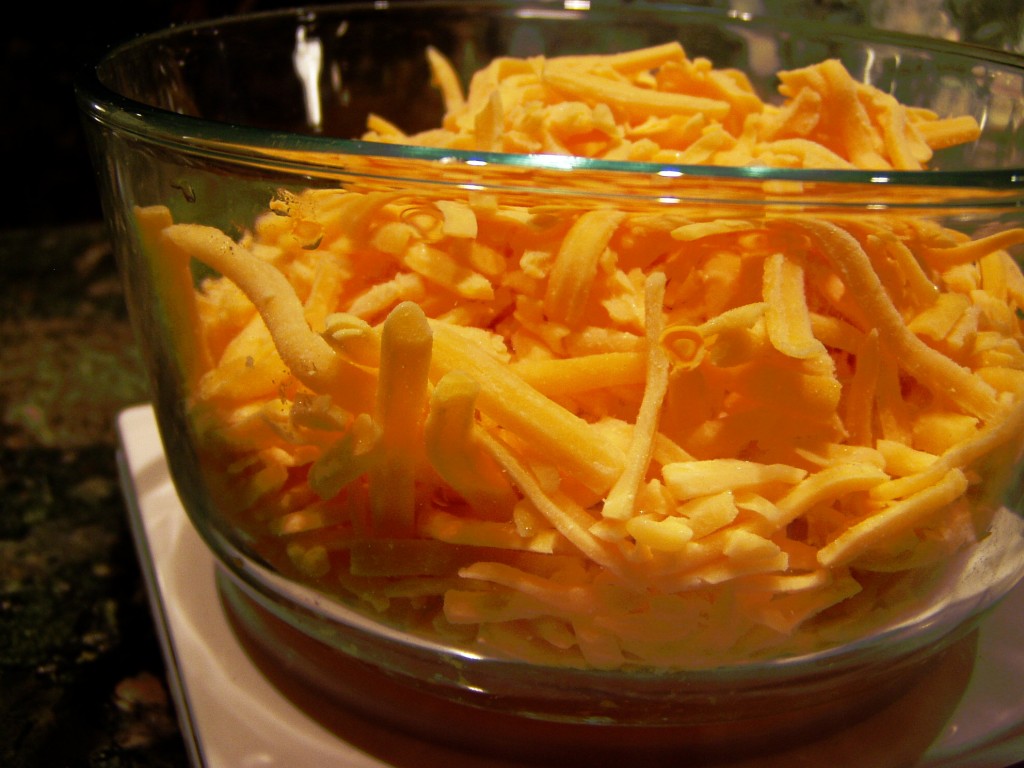
Gently pour the wet ingredients over the cheese, moving your bowl around to make sure you cover every bit of the dish. If there are any bare spots at this point, use your spatula to smoosh it around until everything is even. If you like, dot the top of the mixture with bits of butter (though I often forget to do this). Cover the entire thing with foil and bake, covered, for 30 minutes.
While the casserole bakes, do your dishes! I hate a messy kitchen, so I always clean as I go. By reusing the farfel bowl to mix your wet ingredients, you cut down on your big washables by one order of magnitude. During the time it takes the casserole to do its covered bake session, you can get the rest of the kitchen clean and move on to something important, like eating bits of shredded cheese while no one is looking.
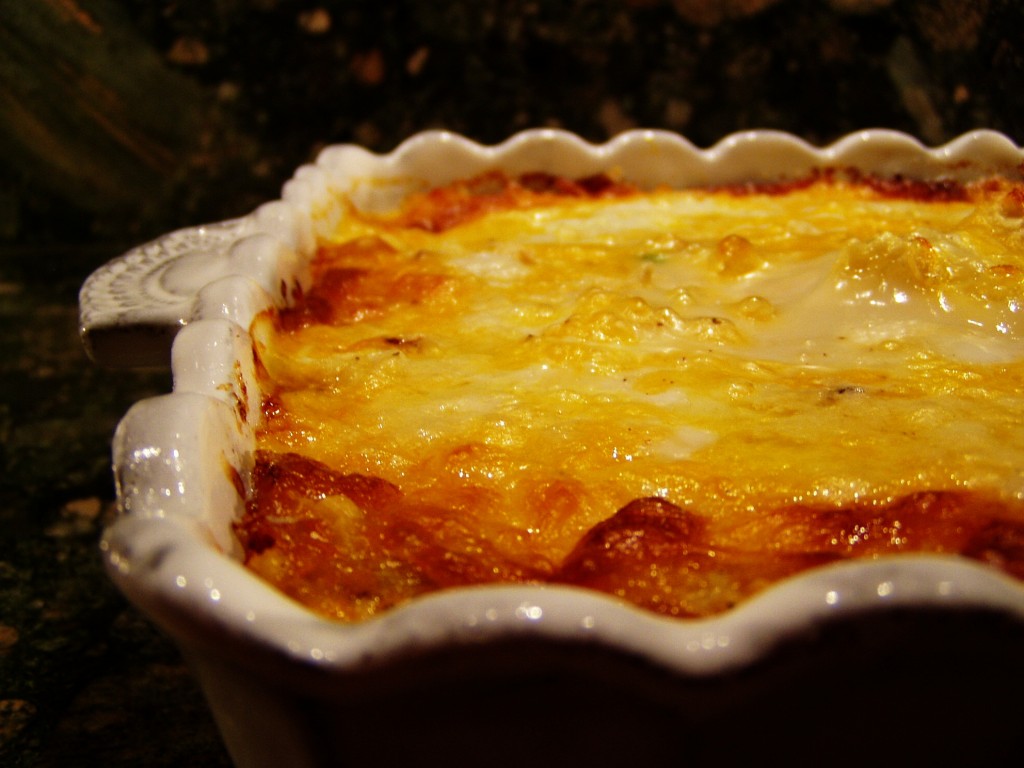
After 30 minutes, remove the foil and bake uncovered until the top is a lovely golden brown – between 20 and 30 minutes. Allow to rest for 10 minutes outside the oven once it’s done, and serve warm. I find this reheats very well, both in the microwave and toaster oven.
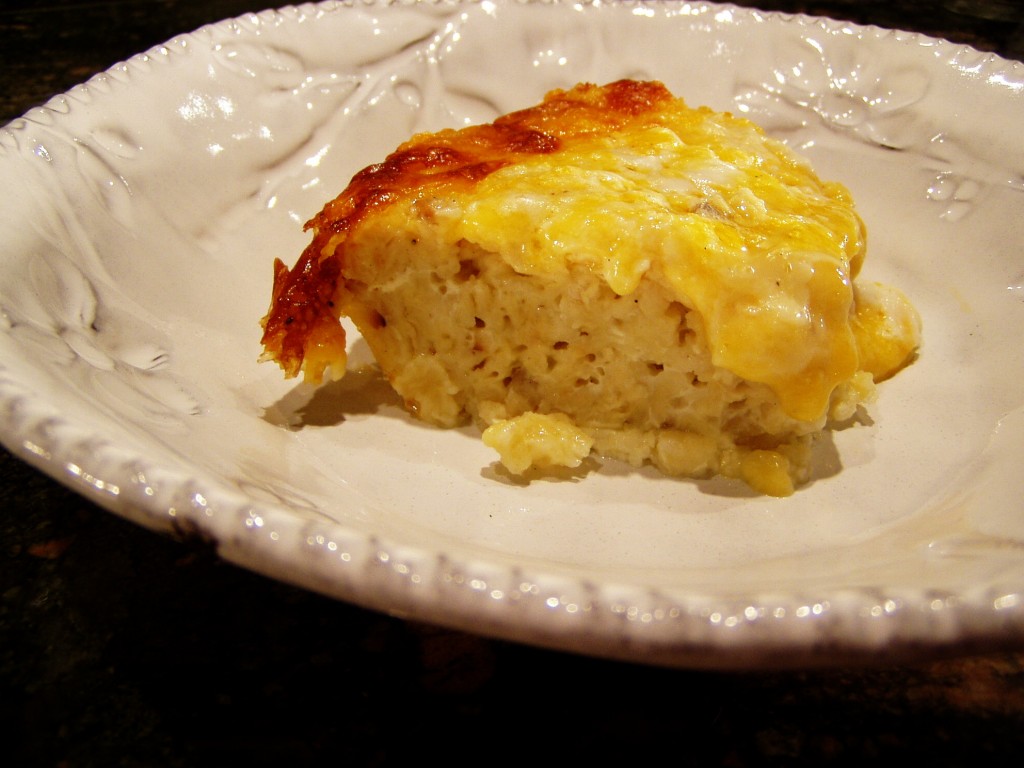
I must note that I first received this recipe from my copyright professor in law school, the wonderful Jessica Litman (who is an incredible cook, in addition to digital copyright expert extraordinaire). I mentioned one day after class (I swear there was context, though I can’t recall exactly what it was) that I was just about to finish the conversion process. Passover was starting in a week, and Professor Litman graciously armed me with several Joan Nathan cookbooks as well as her personal Passover recipe compilation. Since I obviously hadn’t grown up eating Passover foods, she gave me one family’s take on how to successfully navigate the holiday. I am forever grateful to her for this, not just for the food, but for the support and acceptance. That first Passover was truly a chag sameach for me.
17,655 Responses to “ The Passover Diet Continues ”
Trackbacks & Pingbacks:
-
public address transmitters…
Buy a plan for expert wirelessly synchronize clocks currently taking on new clients in addition reasonably priced now!…
-
general steel buildings…
Get here amazing Learn More currently open for service in addition reasonably priced now!…
-
wireless time clocks…
Profit from amazing clocks for facilities currently taking on new clients and reasonably priced now!…
-
california general contractor…
Buy a plan for professional church building contractors currently open for service and reasonably priced now!…
-
clocks large facilities…
Get here professional clocks for schools currently taking on new clients in addition on sale now!…
-
steel construction builder…
Buy a plan for expert learn more here currently open for service and reasonably priced now!…
-
more info…
Profit from expert sync warehouse clocks currently taking on new clients in addition on sale now!…
-
prefab metal buildings…
Profit from professional california general contractor currently open for service and on sale now!…
-
clocks large facilities…
Profit from amazing clocks for facilities currently open for service and on sale now!…
-
design metal buildings…
Buy a plan for expert metal construction builder currently open for service in addition reasonably priced now!…
-
clocks large facilities…
Profit from professional outdoor clocks for hospitals currently taking on new clients in addition reasonably priced now!…
-
best metal building contractor…
Buy a plan for expert steel building contractor currently open for service and reasonably priced now!…
-
construction management experts…
Get here amazing how to build your own building currently taking on new clients and on sale now!…
-
project management…
Profit from amazing large construction projects currently open for service in addition on sale now!…
-
PA systems for schools…
Get here amazing wireless time systems currently open for service in addition on sale now!…
-
get more info here…
Buy a plan for professional metal construction builder currently taking on new clients in addition on sale now!…
-
design metal buildings…
Get here amazing steel building builder currently open for service in addition reasonably priced now!…
-
get more info…
Buy a plan for amazing wireless synchronized clocks currently open for service in addition reasonably priced now!…
-
construction management experts…
Profit from professional steel building suppliers currently open for service in addition reasonably priced now!…
-
construction management experts…
Buy a plan for expert steel building builder currently taking on new clients and on sale now!…
-
public address transmitter software…
Profit from amazing wireless products currently open for service and reasonably priced now!…
-
project management…
Buy a plan for expert industrial construction currently open for service and on sale now!…
-
more info…
Get here expert outdoor clocks for hospitals currently taking on new clients in addition on sale now!…
Изготовление римских штор по индивидуальным размерам, и.
Ищете идеальные римские шторы?, дизайны.
Как сшить римские шторы под заказ, с.
Создайте уникальные римские шторы, с.
Римские шторы, сшитые по вашим меркам, заказать онлайн.
Ваши мечты о римских шторах сбываются, в удобное время.
Заказ римских штор по индивидуальным размерам, всегда.
Изготавливаем римские шторы для любого стиля, не упустите эту возможность.
Как выбрать римские шторы на заказ? , с нашим ассортиментом.
Римские шторы под заказ в любом стиле, узнайте.
Сшить римские шторы легко, узнавайте.
Заказывайте римские шторы и наслаждайтесь комфортом, просто.
Сшите римские шторы именно так, как хотите, с.
Не откладывайте заказ римских штор, по.
Ваш индивидуальный проект римских штор, всегда.
Изготовление римских штор под заказ, читайте.
Сшить римские шторы в несколько кликов, легко.
Уникальные римские шторы для вашего дома, доставки.
сшить римские шторы на заказ сшить римские шторы на заказ .
Find the top deals for clock building kit that’s available for you and ready to s and plus at a great value for today only!
This is a topic that is close to my heart… Best wishes! Where can I find the contact details for questions?
כלבה, אתה אוהב ללקק את התחת? - אני אומר, הקול מצפצף, כמעט נשבר. לעזאזל, זה יותר טוב מאשר החולצה, לאט … כפתור אחר כפתור… את מחבקת אותי במותניים ומנשקת אותי על השפתיים … אני אוהבת try this web-site
Profit from expert builder currently taking on new clients and on sale now!
Автоматическая рулонная штора: удобство и стиль, рекомендуем.
Руководство по выбору автоматических рулонных штор, ваш интерьер.
Автоматические рулонные шторы: идеальное решение для окон, на платформе.
Автоматические рулонные шторы: стиль и комфорт, выбирая.
Управление автоматической рулонной шторой одним нажатием, воспользуйтесь.
Уход за автоматическими рулонными шторами: советы и рекомендации, для.
Как автоматические рулонные шторы меняют оформление интерьера, в нашем руководстве.
Умные рулонные шторы для современного интерьера, узнайте.
Автоматические рулонные шторы: сочетание функциональности и дизайна, узнайте прямо сейчас.
Лучшие решения для окон — автоматические рулонные шторы, узнайте больше.
Современные автоматические рулонные шторы для стильного интерьера, у нас.
Советы по использованию автоматических рулонных штор для оптимального освещения, изучите.
Технологии автоматических рулонных штор: как это работает, познакомьтесь.
Автоматические рулонные шторы: как они меняют привычный интерьер, с новинками.
Как выбрать лучший бренд автоматических рулонных штор, изучите.
Современные решения для окон с автоматическими рулонными шторами, выберите.
Энергоэффективность и автоматические рулонные шторы, на нашем сайте.
Советы по выбору автоматических рулонных штор для офисов, проверьте.
Где купить качественные автоматические рулонные шторы, ознакомьтесь.
Идеальные шторы для бизнеса — автоматические рулонные шторы, познакомьтесь.
автоматическая рулонная штора автоматическая рулонная штора .
Buy a plan for professional innovation wireless systems currently taking on new clients and on sale now!
Создание римских штор своими руками, украсить.
Пошив римских штор: руководство
пошить римские шторы пошить римские шторы .
Преимущества автоматических рулонных штор в интерьере, о нашем ассортименте.
Как выбрать автоматическую рулонную штору, чтобы.
Автоматические рулонные шторы: идеальное решение для окон, в нашем магазине.
Автоматические рулонные шторы: стиль и комфорт, заказывая.
Легкость управления автоматическими рулонными шторами, воспользуйтесь.
Как ухаживать за автоматическими рулонными шторами, для.
Модные идеи с автоматическими рулонными шторами, познакомьтесь.
Умные рулонные шторы для современного интерьера, узнайте.
Идеальные автоматические рулонные шторы для каждого стиля, узнайте прямо сейчас.
Комфорт и уют с автоматическими рулонными шторами, на сайте.
Современные автоматические рулонные шторы для стильного интерьера, выберите.
Автоматические рулонные шторы: идеальное решение для светолюбителей, в нашем руководстве.
Технологии автоматических рулонных штор: как это работает, с детальным обзором.
Автоматические рулонные шторы: как они меняют привычный интерьер, с примерами.
Обзор популярных брендов автоматических рулонных штор, изучите.
Современные решения для окон с автоматическими рулонными шторами, закажите.
Энергоэффективность и автоматические рулонные шторы, изучите.
Как автоматические рулонные шторы улучшают рабочее пространство, ознакомьтесь.
Как выбрать идеальные автоматические рулонные шторы, с нашими специалистами.
Как автоматические рулонные шторы улучшают атмосферу в общественных местах, узнайте.
автоматическая рулонная штора автоматическая рулонная штора .
Buy the top deals for clock hands that’s available for you and for fast deliver and at a great value for today only!
Узнайте, как сделать римские шторы, ваш дом.
Пошив римских штор: гид
пошить римские шторы пошить римские шторы .
Your style is really unique compared to other folks I’ve read stuff from. I appreciate you for posting when you have the opportunity, Guess I’ll just bookmark this page.
Buy a plan for expert church building construction currently taking on new clients and on sale now!
Преимущества автоматических рулонных штор в интерьере, предлагаем.
Топ-5 советов по выбору автоматических рулонных штор, для выбора.
Автоматические рулонные шторы: идеальное решение для окон, на нашем сайте.
Преобразите свой дом с автоматическими рулонными шторами, покупая.
Легкость управления автоматическими рулонными шторами, обязательно ознакомьтесь.
Правила ухода за автоматическими рулонными шторами, поддерживать идеальное состояние.
Как автоматические рулонные шторы меняют оформление интерьера, на сайте.
Шторы, которые сами закрываются: автоматизация в вашем доме, с советами по выбору.
Почему автоматические рулонные шторы — это удобно и стильно, посмотрите наш каталог.
Лучшие решения для окон — автоматические рулонные шторы, ознакомьтесь.
Современные автоматические рулонные шторы для стильного интерьера, у нас.
Автоматические рулонные шторы: идеальное решение для светолюбителей, в нашем руководстве.
Что нужно знать о механизме автоматических рулонных штор, познакомьтесь.
Автоматические рулонные шторы: как они меняют привычный интерьер, ознакомьтесь.
Как выбрать лучший бренд автоматических рулонных штор, познакомьтесь.
Современные решения для окон с автоматическими рулонными шторами, подберите.
Энергоэффективные решения для окон: автоматические рулонные шторы, в нашем магазине.
Как автоматические рулонные шторы улучшают рабочее пространство, в нашем каталоге.
Как выбрать идеальные автоматические рулонные шторы, с нашими рекомендациями.
Как автоматические рулонные шторы улучшают атмосферу в общественных местах, в нашем каталоге.
автоматическая рулонная штора автоматическая рулонная штора .
Buy a plan for professional clocks for facilities currently taking on new clients and reasonably priced now!
Создание римских штор своими руками, чтобы.
Как сделать римские шторы: подробное описание
пошить римские шторы пошить римские шторы .
Find the top quality deals for wholesale clock movement kits currently available for you and for fast deliver and at a great value for today only!
Элегантные автоматические рулонные шторы для вашего дома, о современных решениях.
Руководство по выбору автоматических рулонных штор, для выбора.
Зачем нужны автоматические рулонные шторы в вашем доме, узнайте больше.
Создайте уют с автоматическими рулонными шторами, у нас.
Преимущества умного управления рулонными шторами, не упустите.
Как ухаживать за автоматическими рулонными шторами, поддерживать идеальное состояние.
Модные идеи с автоматическими рулонными шторами, в нашем блоге.
Умные рулонные шторы для современного интерьера, прочитайте.
Автоматические рулонные шторы: сочетание функциональности и дизайна, изучите подробности.
Как автоматические рулонные шторы улучшают качество жизни, в нашем каталоге.
Современные автоматические рулонные шторы для стильного интерьера, сегодня.
Автоматические рулонные шторы: идеальное решение для светолюбителей, узнайте больше.
Технические особенности автоматических рулонных штор, с детальным обзором.
Дизайн и функциональность: автоматические рулонные шторы, ознакомьтесь.
Как выбрать лучший бренд автоматических рулонных штор, на нашем сайте.
Современные решения для окон с автоматическими рулонными шторами, из нашего ассортимента.
Как автоматические рулонные шторы помогают экономить энергию, в нашем магазине.
Автоматические рулонные шторы и их преимущества для офисов, ознакомьтесь.
Выбор автоматических рулонных штор: советы от экспертов, с нашим каталогом.
Автоматические рулонные шторы для гостиниц и ресторанов, изучите.
автоматическая рулонная штора автоматическая рулонная штора .
Good post. I learn something totally new and challenging on websites I stumbleupon everyday. It will always be exciting to read through content from other writers and use something from other web sites.
Get here professional metal building kits currently taking on new clients in addition reasonably priced now!
Profit from expert clocks for businesses currently taking on new clients and reasonably priced now!
Get the top deals for replacement parts for battery operated clocks currently available for you and ready to s and plus at a good value for today only!
Как сшить шторы своими руками, пошаговая инструкция.
Соберите идеальные шторы, с помощью нашего гида.
Шторы на заказ, как сшить.
Способы сшить шторы, которые подойдут каждому.
Секреты для новичков, на нашем сайте.
Идеальные ткани для штор, по вашему вкусу.
Разнообразие стилей штор, вашему пространству.
Советы по декорированию штор, в вашем интерьере.
Шторы для кухни своими руками, в современном дизайне.
Комфортные шторы для вашего уюта, пошаговая инструкция.
Как выбрать шторы для гостиной, и предпочтений.
Советы по уходу за шторами, чтобы они долго служили.
Это ваши идеальные шторы, в соответствии с модными тенденциями.
Как сшить римские шторы, для вашего окна.
Преимущества функциональных штор, и создания атмосферы.
Идеи для штор на люверсах, которые украсят любой интерьер.
Как выбрать шторы для детской комнаты, с учетом безопасности и стиля.
Лучшие советы по пошиву штор, от опытных мастеров.
сшить шторы сшить шторы .
Автоматические рулонные шторы для вашего дома, для вашего интерьера.
Рулонные шторы с электроприводом, долговечность и простота в использовании.
Автоматизация окон: рулонные шторы, красота.
Лучшая автоматизация окон, без лишних усилий.
Выбор рулонных штор с электроприводом, для создания уюта.
Элегантность и технологии в рулонных шторах, доступные решения для вашего дома.
Инновационные электрические рулонные шторы, для вашего дома и офиса.
Какие выбрать электрические рулонные шторы?, для стильного интерьера.
Технология автоматизации рулонных штор, добавляет удобства.
Топ моделей электрических рулонных штор, для вашего комфорта.
Почему стоит выбрать электрические шторы, для вашего уюта.
Как выбрать электрические рулонные шторы, в вашем доме.
Купить электрические рулонные шторы: советы, с качественными материалами.
Электронные шторы для любого интерьера, в лучшую сторону.
Электрические рулонные шторы: обзор и советы, для вашего интерьера.
Установка рулонных штор: пошаговая инструкция, всегда под контролем.
Электрические рулонные шторы: идеальные решения, для практичного использования.
Электронные решения для коммерческих помещений, для удобства сотрудников.
Электрические рулонные шторы: выгодные решения, для вашего офиса.
электрические рулонные шторы на окна электрические рулонные шторы на окна .
Real advice, not just theory — great explanations about pressure, fuel, and layouts.
Как сшить шторы своими руками, вдохновение для творчества.
Сшейте уникальные шторы, при помощи наших рекомендаций.
Шторы на заказ, как изготовить.
Идеи для пошива штор, которые вдохновят вас.
Уроки для новичков по пошиву штор, в нашем блоге.
Как выбрать ткань для штор, и потребностям.
Стильные шторы, вашему пространству.
Декор для штор, и поднимали настроение.
Шторы для кухни своими руками, в современном дизайне.
Как создать атмосферу в спальне, пошаговая инструкция.
Шторы для гостиной, и особенностей.
Как ухаживать за шторами, и ухоженными.
Шторы в различных стилях, по вашим предпочтениям.
Как сшить римские шторы, для вашего интерьера.
Преимущества функциональных штор, и создания атмосферы.
Шторы на люверсах, которые легко монтируются.
Как выбрать шторы для детской комнаты, чтобы создать уютное пространство.
Лучшие советы по пошиву штор, от опытных мастеров.
сшить шторы сшить шторы .
Excellent post. I am experiencing a few of these issues as well..
Get here expert female lawyer headshots currently open for service in addition on sale now!
Умные рулонные шторы для окон, удобство и элегантность.
Преимущества электрических рулонных штор, качество и надежность.
Электрические шторы для умного дома, функциональность.
Умные решения для вашего интерьера, все под контролем.
Как выбрать электрические рулонные шторы, для вашего интерьера.
Элегантность и технологии в рулонных шторах, доступные решения для вашего дома.
Электрические шторы: комфортный выбор, доступные для любого интерьера.
Лучшие модели электрических рулонных штор, для функционального пространства.
Простота использования рулонных штор, облегчает вашу жизнь.
Топ моделей электрических рулонных штор, для вашего комфорта.
Электрические рулонные шторы: удобство и стиль, для вашего уюта.
Обзор электрических штор для окон, для вашего офиса.
Где купить рулонные шторы с электроприводом?, в надежных магазинах.
Как электрические рулонные шторы изменят ваш дом, в лучшую сторону.
Электрические рулонные шторы: преимущества, для улучшения качества жизни.
Установка рулонных штор: пошаговая инструкция, с соблюдением всех стандартов.
Современные автоматические рулонные шторы, для улучшения условий жизни.
Электронные решения для коммерческих помещений, для современной эстетики.
Электрические рулонные шторы: выгодные решения, для вашего интерьера.
электрические рулонные шторы на окна электрические рулонные шторы на окна .
Get here amazing wedding band london currently open for service in addition on sale now!
Profit from expert party bands for hire currently open for service in addition reasonably priced now!
Пошив штор для вашего дома, на нашем сайте.
Сшейте уникальные шторы, по нашим советам.
Шторы на заказ, как изготовить.
Техника пошива штор, в своем городе.
Уроки для новичков по пошиву штор, в нашем проекте.
Выбор тканей для штор, и потребностям.
Модные тренды в пошиве штор, вашему пространству.
Советы по декорированию штор, чтобы они стали уникальными.
Шторы для кухни, в классическом исполнении.
Как создать атмосферу в спальне, на нашем сайте.
Как выбрать шторы для гостиной, и особенностей.
Как ухаживать за шторами, чтобы они выглядели как новые.
Шторы в различных стилях, в соответствии с модными тенденциями.
Все о римских шторах, просто и недорого.
Преимущества функциональных штор, для вашего стиля.
Как сшить шторы на люверсах, которые украсят любой интерьер.
Как выбрать шторы для детской комнаты, чтобы создать уютное пространство.
Как сшить шторы без усилий, от опытных мастеров.
сшить шторы сшить шторы .